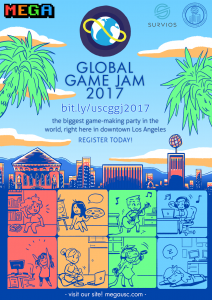Global Game Jam inspires teamwork with game creation

Photo courtesy of Jocelyn Kim
It’s all in the game · USC hosted the second annual Global Game Jam, with participants programming, designing and writing art and music for products such as robots, video games and board games.
From Friday to Sunday, the second floor of the USC School of Cinematic Arts was transformed into a gaming central for the annual Global Game Jam. Creators and programmers were sprawled all around, working together or independently on their games.
GGJ is a three-day international gaming event. It was started in 2009 with about 50 “jam sites.” This year, there were over 702 sites and 36,000 gamers participating in this program. USC has participated in GGJ since at least 2013 through the student run organization MEGA: Makers of Entertaining Games Association.
The event kicked off on Friday evening with a livestream that revealed this year’s secret theme — waves — and a speech by MEGA president Manolo Rosenberg to the 200 participants. Afterward, the two days of programming, designing and writing with art and music creation commenced. Participants created a wide variety of games, ranging from video games to robotics to traditional card and board games.
“It’s incredible watching what people can make in 48 hours,” Rosenberg said.
Rosenberg, a junior majoring in Interactive Entertainment major, has participated in Global Game Jams since his freshman year and has risen to be one of the main organizers of the event.
“So many different people come to the jams,” he said. “GGJ is about skill sharing, networking and forging friendships, regardless of how people identify.”
Rosenberg recounts a year when he watched his family from Lebanon create games and participate in another GGJ from across the ocean.
“People all over the world make something, no matter what the political climate. It’s really reassuring that people are continuing to create art,” he said.
The event is open to anyone is the L.A. area, and USC hosts one of the largest sessions in the country, with alumni bringing it to other parts of California as well. Children and their parents, students from neighboring schools and industry individuals are invited to attend and partake in GGJ. Everyone is welcome, even those with no programming or gaming experience.
“Game culture is one of community and mentorship,” said Lex Rhodes, the MEGA Vice President. “Gaming and video game design education is new so a lot is learned from skill sharing or self teaching.”
All participants are encouraged to ask for help and learn from each other, the industry members who attend and the student board throughout the course of the program.
GGJ brought new technologies in for participants to explore. This year, virtual reality kits from Oculus were provided and the creators were encouraged to play around with them, learning to incorporate them into their games.
Although game creation was the main activity of the event, Rosenberg emphasized the importance of taking breaks and enjoying time with others in the community during GGJ. In previous years, the group even did yoga to the landscape video game Proteus and other creative activities between the programming.
Sunday evening, all the games were uploaded and became available to everyone to play. This open arcade session lasted for a few hours before the judging and prizes were awarded in four categories: aesthetics, best game play, best use of the theme and overall favorite.
The judges of this year’s program were representatives from one of the main sponsors of the event — Survios — alongside other industry officials.
But, Rosenberg maintains that though there was a competitive aspect to GGJ, it was not the main focus of the event.
“Global Game Jam is about collaboration and encouraging creativity,” he said. “Once a year everyone gets to come together and make something amazing.”
